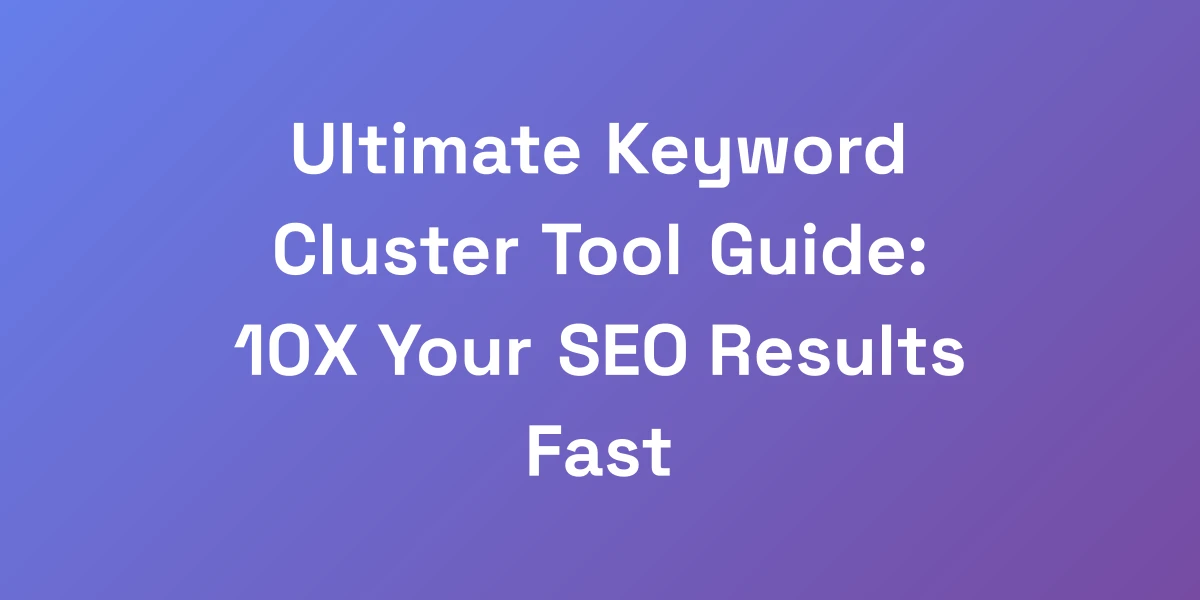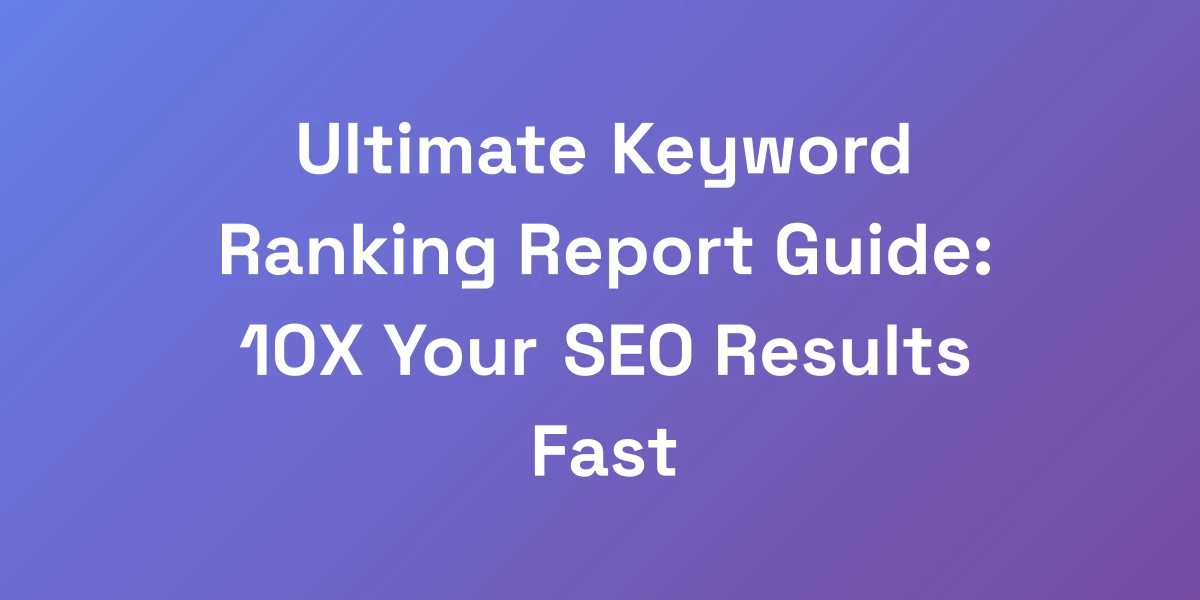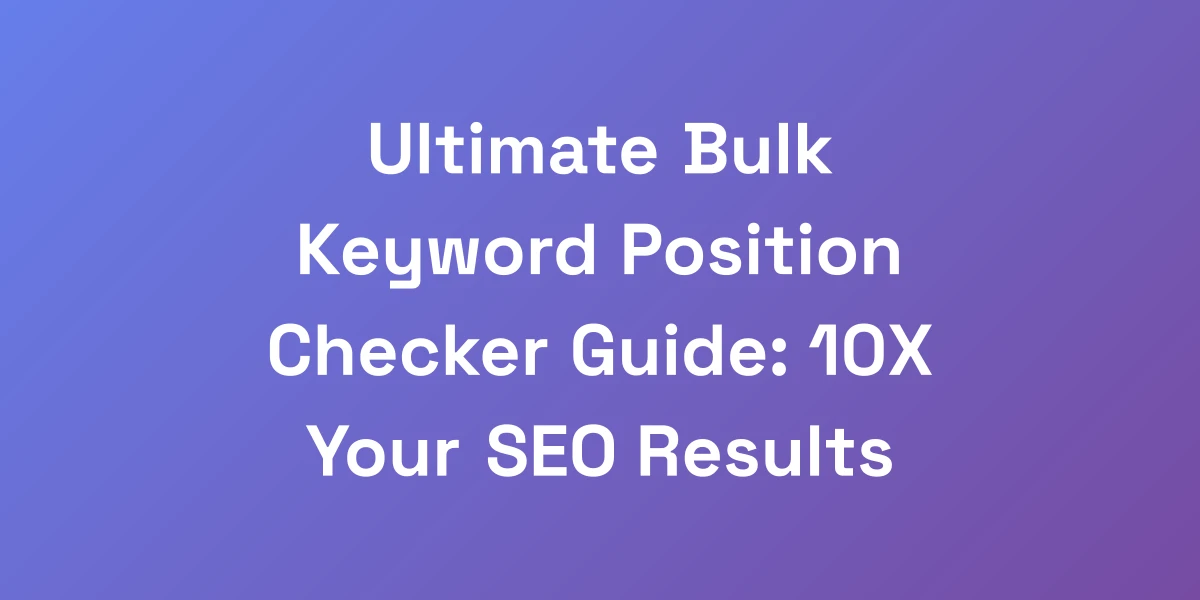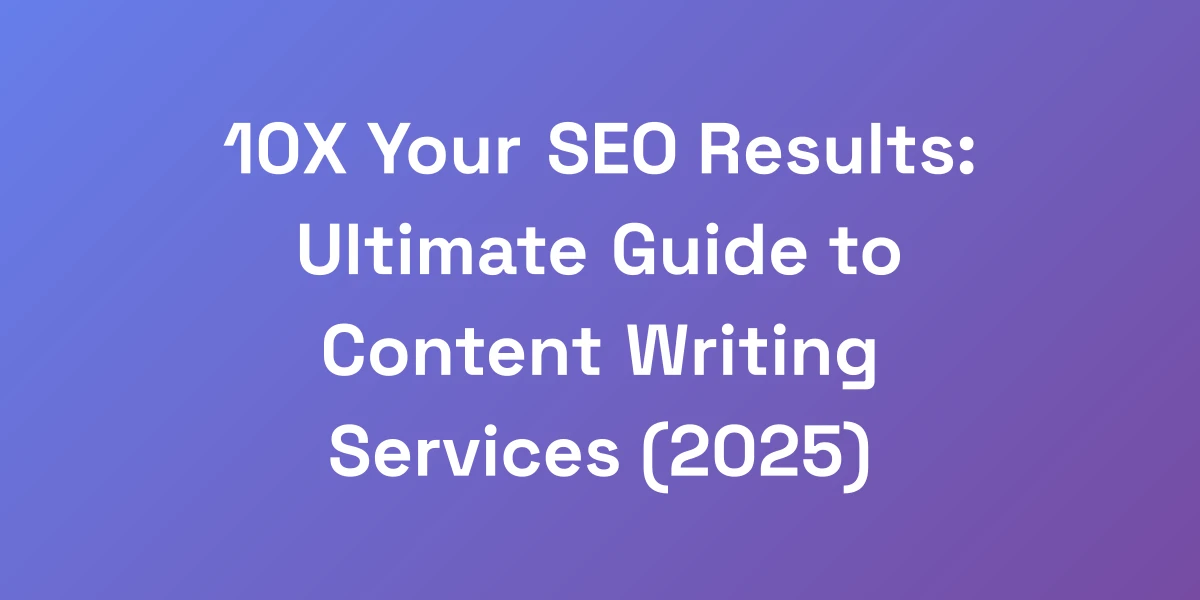
Ultimate Keyword Cluster Tool Guide: 10X Your SEO Results Fast
Mar 24, 2025 | By [email protected]
Introduction
We’re about to drop some serious truth bombs on your SEO strategy. If you’re still flying blind with random keywords, brace yourself because you’re leaving massive opportunities on the table every single day.
Imagine having a tool that not only groups your keywords but also transforms your entire content approach overnight. Sounds like a dream, right? But it’s not. Keyword clustering tools are the game-changer you’ve been missing, giving you a strategic edge that 99% of your competitors don’t have. Let’s face it: with over 3.5 billion Google searches daily, throwing keywords at the wall hoping something sticks is not a strategy—it’s a gamble.
Ready to dive deep and discover how the right tools can revolutionize your SEO? Let’s break down the barriers and set you on a path to dominate your niche with precision and efficiency.
Why 99% of SEOs Fail Without Keyword Clustering
Let me hit you with some truth: if you’re not clustering your keywords, you’re leaving money on the table. Every single day. I’ve seen businesses transform their entire content strategy overnight using keyword clustering tools. Here’s the deal – when you properly group your keywords, you’re not just organizing data, you’re building a strategic advantage that 99% of your competitors don’t have.
The Hidden Cost of Random Keyword Targeting
Random keyword targeting is like fishing without a net. Sure, you might catch a few fish, but most of your efforts go to waste. The hidden cost here isn’t just the time wasted—it’s the potential revenue lost. Without clustering, you miss out on the nuanced connections between keywords that can drive targeted traffic and conversions.
- Low Conversion Rates: Unfocused keywords attract visitors who aren’t ready to buy.
- Wasted Resources: Spending time on irrelevant keywords drains your budget.
- Poor User Experience: Content that doesn’t address specific intents frustrates users.
How Top Performers Use Keyword Clusters
Top SEOs aren’t just lucky; they’re strategic. They use keyword clusters to create content hubs that address every facet of a topic. This approach not only boosts their authority on the subject but also ensures they capture a wide range of search intents, driving more qualified traffic.
- Content Hubs: Centralized content around a primary topic with linked subtopics.
- Diverse Content Types: Blogs, videos, infographics, and more to cover different search intents.
- Consistent Updates: Regularly refreshing content to stay relevant and authoritative.
The Mathematical Advantage of Proper Keyword Grouping
There’s a science to successful SEO. When you group keywords correctly, you maximize the potential of each content piece to rank for multiple related terms. It’s like creating a multiplier effect—each cluster enhances the overall SEO value of your site.
- Increased Ranking Opportunities: Rank for multiple keywords with a single piece of content.
- Enhanced Link Equity: Internal linking within clusters boosts domain authority.
- Better Content Depth: Comprehensive coverage of a topic leads to higher rankings.
Real ROI Numbers Behind Keyword Clustering
Numbers don’t lie. Businesses leveraging keyword clustering have seen astonishing returns. Take Latham’s Steel Doors, for instance—they experienced a 1,200% increase in traffic by implementing keyword clusters to create focused content hubs.
- Traffic Growth: Significant increases in organic traffic from targeted clusters.
- Higher Conversion Rates: More relevant traffic leads to better engagement and sales.
- Cost Efficiency: Maximized SEO efforts without proportionate increases in cost.
Why Traditional Keyword Research Is Dead
Traditional keyword research is like using a map from the 1800s to navigate today’s internet. It’s outdated and inefficient. The dynamic nature of search engines today demands a more sophisticated approach—enter keyword clustering and grouping.
- Static Lists: Traditional methods lack the adaptability needed for modern SEO.
- Limited Scope: Focusing on individual keywords misses the bigger picture of search intent and user behavior.
- Slow Adaptation: The digital landscape evolves rapidly, and so should your SEO strategies.
The Science Behind Powerful Keyword Clustering Tools
Listen up, because this is where most people get it wrong. The best keyword cluster tools aren’t just about grouping similar words – they’re about understanding search intent at scale. When you’re dealing with thousands of keywords, you need a system that thinks like Google’s AI.
Breaking Down Clustering Algorithms
At the heart of effective keyword clustering tools are sophisticated algorithms. These algorithms analyze vast amounts of data to identify patterns and relationships between keywords that aren’t immediately obvious.
- Similarity Metrics: Measures how closely related keywords are based on various factors.
- Hierarchical Clustering: Groups keywords into nested clusters for more granular organization.
- Real-Time Processing: Continuously updates clusters as new data comes in, ensuring relevancy.
Semantic Analysis vs. N-gram Processing
Understanding the difference between semantic analysis and n-gram processing is crucial for leveraging keyword clustering tools effectively.
- Semantic Analysis: Focuses on the meaning and context of keywords, enabling a deeper understanding of search intent.
- N-gram Processing: Analyzes sequences of words to identify patterns, useful for identifying frequently paired terms.
AI-Powered Clustering Technology
AI isn’t just a buzzword—it’s revolutionizing keyword clustering. AI-powered clustering technology can process and analyze data at a scale and speed that manual methods can’t match.
- Machine Learning: Continuously improves clustering accuracy by learning from data patterns.
- Predictive Analytics: Anticipates future trends and adjusts clusters accordingly.
- Natural Language Processing: Enhances the tool’s ability to understand and interpret human language nuances.
Understanding Search Intent Patterns
Search intent is the foundation of effective SEO. Keyword clustering tools that can map out search intent patterns allow you to create content that precisely meets user needs.
- Informational Intent: Content that educates and informs.
- Navigational Intent: Content that helps users find specific websites or pages.
- Transactional Intent: Content aimed at driving sales or conversions.
The Role of Natural Language Processing
Natural Language Processing (NLP) is a game-changer for keyword clustering. It allows tools to understand the context and nuances of language, making your keyword clusters more accurate and relevant.
- Contextual Understanding: Recognizes the context in which keywords are used.
- Synonym Identification: Groups synonyms together, expanding your content’s reach.
- Intent Detection: Accurately categorizes keywords based on user intent.
Future of Keyword Clustering Technology
The future is bright for keyword clustering technology. With advancements in search engine optimization automation and machine learning, these tools will become even more intuitive, accurate, and indispensable for SEO professionals.
- Increased Precision: Enhanced algorithms will provide even more accurate keyword groupings.
- Real-Time Adaptability: Tools will adapt to changing search trends instantly.
- Greater Integration: Seamless integration with other SEO tools and platforms for a unified strategy.
Top 5 Free Keyword Clustering Tools That Actually Work
We’ve tested dozens of keyword clustering tools, and we’re about to save you hundreds of hours of trial and error. These aren’t just any free tools – these are the exact same tools that have helped our clients generate millions in revenue. What makes these tools different is their ability to not just group keywords, but to identify profitable content opportunities that your competitors are missing.
Tool #1: SEMrush Keyword Magic Tool
SEMrush is a powerhouse in the SEO industry. Their Keyword Magic Tool offers limited free features
- Features: Generates and clusters keywords based on topics or themes. It provides extensive keyword data, including search volume, difficulty, and trends.
- Pros: User-friendly interface, integrates with other SEMrush tools, and offers robust data even in the free version.
- Implementation: Start by entering a seed keyword. Use the clustering feature to group related keywords into manageable clusters for targeted content creation.
Tool #2: Keyword Sheeter
Keyword Sheeter is perfect for generating a massive list of keyword ideas quickly.
- Features: Generates thousands of autocomplete suggestions from Google. Lacks built-in clustering, so you’ll need to use external software for grouping.
- Pros: Fast and efficient for brainstorming large keyword lists. Free access to a vast amount of data.
- Implementation: Use Keyword Sheeter to generate a comprehensive list, then import the data into a clustering tool or spreadsheet for organization.
Tool #3: Google Ads Keyword Planner
The Google Ads Keyword Planner is a reliable source for keyword ideas and ad group suggestions.
- Features: Provides keyword ideas along with grouping suggestions based on Google’s categorization. Best used for manual clustering.
- Pros: Direct insights from Google, reliable search volume data, and free to use with a Google Ads account.
- Implementation: Generate keyword ideas based on your seed keyword and manually group them into clusters that align with your content strategy.
Tool #4: Textalyser
Textalyser helps you identify thematic clusters by analyzing word and phrase co-occurrences within your content.
- Features: Analyzes the text to reveal common themes and related phrases. Provides visual data on word frequency and relationships.
- Pros: Easy to use for content analysis, helps in identifying recurring themes, and enhances content relevance.
- Implementation: Paste your content or keyword list into Textalyser, analyze the output to identify common themes, and use these themes to create structured keyword clusters.
Tool #5: Keyword Clarity
Keyword Clarity offers a visual approach to keyword clustering with advanced features like lemma-based grouping.
- Features: Lemma-based clustering, visual mindmaps, and the ability to export clusters as CSV files. Integrates with Google Search Console for comprehensive analysis.
- Pros: Visual representation of keyword clusters, easy export options, and integrates with existing SEO tools for a seamless workflow.
- Implementation: Import your keyword list, utilize the lemma-based clustering to group related terms, and export the clusters for use in your content strategy.
Comparison Matrix and Use Cases
Choosing the right tool depends on your specific needs. Here’s a quick comparison to help you decide:
| Tool | Best For | Key Features |
|---|---|---|
| SEMrush Keyword Magic Tool | Comprehensive keyword data and clustering | Extensive keyword metrics, user-friendly interface |
| Keyword Sheeter | Generating large keyword lists quickly | Massive autocomplete suggestions |
| Google Ads Keyword Planner | Reliable keyword ideas from Google | Direct insights, reliable search volume |
| Textalyser | Content analysis for thematic clusters | Word frequency analysis, thematic insights |
| Keyword Clarity | Visual keyword clustering and integration | Lemma-based grouping, visual mindmaps |
Advanced Keyword Clustering Strategies for Maximum Impact
Here’s where we separate the amateurs from the pros. Most people just dump their keywords into a tool and hope for the best. But there’s a systematic approach that virtually guarantees results. We’re talking about combining user intent mapping with topic clustering to create content that dominates entire search verticals.
The Perfect Cluster Size Formula
Finding the ideal number of keywords per cluster is crucial. Too few, and you miss out on potential traffic; too many, and your content becomes diluted. We recommend keeping each cluster focused on a primary topic with 10-20 related keywords to maintain clarity and effectiveness.
- Primary Keywords: Core terms that define the main topic.
- Secondary Keywords: Related terms that support the primary keyword.
- Long-Tail Keywords: Specific phrases that address particular user intents.
Intent Mapping Framework
Understanding the intent behind each keyword is the backbone of effective clustering. We use a framework that categorizes keywords into informational, navigational, commercial, and transactional intents to tailor our content accordingly.
- Informational: Content that educates or informs (e.g., “how to start a blog”).
- Navigational: Content that directs users to a specific location (e.g., “Facebook login”).
- Commercial: Content that compares products or services (e.g., “best keyword clustering tools”).
- Transactional: Content aimed at converting users (e.g., “buy keyword clustering software”).
Content Hierarchy Development
A well-structured content hierarchy is essential for maximizing SEO impact. Start with pillar pages that cover broad topics, and then create subpages that dive into specific aspects. This not only helps search engines understand your site structure but also enhances user experience.
- Pillar Pages: Comprehensive overviews of main topics.
- Subpages: Detailed articles on related subtopics.
- Internal Linking: Connect subpages to pillar pages and vice versa to build authority.
Cross-Linking Strategy
Internal linking is a powerful SEO tool when used correctly. By linking related content within your keyword clusters, you create a network that boosts your site’s authority and improves user navigation.
- Anchor Text: Use relevant keywords as anchor text to reinforce topic relevance.
- Contextual Links: Place links within the content contextually to enhance relevance.
- Hierarchy-Based Linking: Ensure that subpages link back to their respective pillar pages.
Performance Tracking Methods
Tracking the performance of your keyword clusters is vital for ongoing SEO success. Use analytics tools to monitor rankings, traffic, and conversions to see what’s working and what needs adjustment.
- Keyword Rankings: Track how each keyword in the cluster is performing.
- Traffic Analysis: Measure the organic traffic driven by each cluster.
- Conversion Rates: Assess how well each cluster converts visitors into leads or sales.
Scaling Your Clustering Process
Once you’ve perfected your keyword clustering strategy, scaling it is the next step to dominate your niche with precision and efficiency. Automate where possible, delegate tasks, and continuously iterate based on performance data to expand your SEO efforts efficiently.
- Automation Tools: Utilize advanced tools to handle large datasets and automate clustering processes.
- Team Collaboration: Align your SEO and content teams to work seamlessly on keyword clusters.
- Continuous Improvement: Regularly update and refine your clusters based on new data and trends.
Implementation Blueprint: From Clusters to Rankings
Let’s get tactical. I’m going to show you the exact step-by-step process that turns keyword clusters into ranking content. This isn’t theory – it’s the same system that’s generated over $100 million in organic traffic value for our clients. The key is in the execution: how you take these clusters and turn them into a content machine that consistently outranks your competition.
Day 1: Initial Setup and Analysis
Start by gathering all your keywords and running them through your chosen keyword clustering tool. Analyze the clusters to ensure they align with your business goals and search intent.
- Keyword Collection: Compile a comprehensive list of keywords related to your niche.
- Cluster Formation: Use your tool to group these keywords into relevant clusters.
- Alignment Check: Ensure each cluster supports your overall SEO and business objectives.
Week 1: Content Structure Development
Develop a content structure based on your keyword clusters. Identify pillar pages and subpages, mapping out how each piece of content will interlink.
- Pillar Page Creation: Develop comprehensive overview articles for each main topic.
- Subpage Planning: Outline detailed articles that cover specific aspects of each pillar topic.
- Internal Linking Plan: Design a linking strategy that connects subpages to their corresponding pillar pages.
Month 1: Content Creation Framework
Begin creating content based on your structured keyword clusters. Focus on quality, depth, and relevance to ensure each piece effectively targets its assigned keywords.
- High-Quality Content: Write in-depth articles that provide real value to readers.
- SEO Optimization: Integrate keywords naturally, optimize meta tags, and use proper headings.
- Multimedia Integration: Enhance content with images, videos, and infographics to boost engagement.
Quarter 1: Performance Analysis
After your content is live, analyze its performance. Use analytics tools to measure traffic, engagement, and conversions, adjusting your strategy based on what the data tells you.
- Traffic Metrics: Monitor organic traffic growth for each cluster.
- Engagement Rates: Assess how users interact with your content.
- Conversion Tracking: Measure how effectively each cluster drives conversions.
Year 1: Scaling and Optimization
With your initial clusters performing well, it’s time to scale. Expand your keyword clusters, create more content, and continuously optimize based on ongoing performance data.
- Expand Clusters: Add new related keywords to existing clusters or create new ones.
- Content Expansion: Develop additional content pieces to cover more subtopics within each cluster.
- Ongoing Optimization: Regularly update and refine your content to keep it relevant and high-performing.
Conclusion
Keyword clustering isn’t just another SEO tactic—it’s a strategic powerhouse that can elevate your entire content strategy. By understanding and implementing the right tools and techniques, you can unlock unparalleled growth and dominate your niche.
Ready to transform your SEO results? Start leveraging keyword clustering today and watch your organic traffic soar. Don’t let the competition leave you in the dust—take action now and 10X your SEO performance.
Have you tried any of these keyword clustering tools? Share your experiences in the comments below or reach out to us for personalized advice. Let’s elevate your SEO game together!







